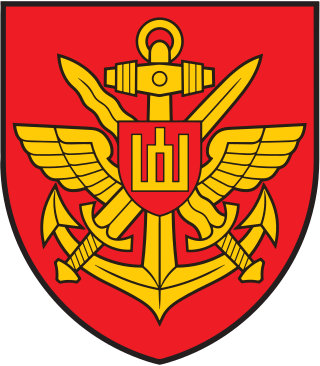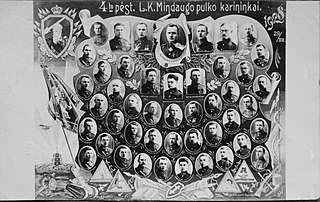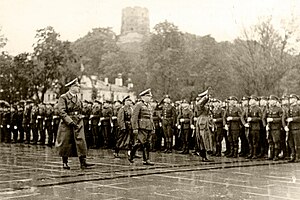
The June Uprising was a brief period of the history of Lithuania in late June 1941 between the first Soviet and the Nazi occupations.

The Schutzmannschaft, or Auxiliary Police was the collaborationist auxiliary police of native policemen serving in those areas of the Soviet Union and the Baltic states occupied by Nazi Germany during World War II. Heinrich Himmler, head of the SS, established the Schutzmannschaft on 25 July 1941, and subordinated it to the Order Police. By the end of 1941, some 45,000 men served in Schutzmannschaft units, about half of them in the battalions. During 1942, Schutzmannschaften expanded to an estimated 300,000 men, with battalions accounting for about a third, or less than one half of the local force. Everywhere, local police far outnumbered the equivalent German personnel several times; in most places, the ratio of Germans to natives was about 1-to-10.
The Lithuanian Security Police (LSP), also known as Saugumas, was a local police force that operated in German-occupied Lithuania from 1941 to 1944, in collaboration with the occupational authorities. Collaborating with the Nazi Sipo and SD, the unit was directly subordinate to the German Kripo. The LSP took part in perpetrating the Holocaust in Lithuania, persecuting the Polish resistance and communist underground.
Algirdas Klimaitis was a Lithuanian paramilitary commander, infamous for his role in the Kaunas pogrom in June 1941. Klimaitis was likely an officer in the Lithuanian Army. During the pre-war years he was editor of the tabloid Dešimt centų. His attitudes shifted to anti-communism and antisemitism. He joined the Voldemarininkai movement.

Petras Kubiliūnas was a Lithuanian lieutenant general and Chief of the Lithuanian General Staff in 1929–1934.
The Lithuanian TDABattalion or simply TDA, was a paramilitary battalion organized in June–August 1941 by the Provisional Government of Lithuania at the onset of Operation Barbarossa. Members of the TDA were known by many names such as Lithuanian auxiliaries, policemen, white-armbands, nationalists, rebels, partisans, resistance fighters or Schutzmannschaften. TDA was intended to be the basis for a future independent Lithuanian Army, but it was taken over by Nazis and reorganized into the Lithuanian Auxiliary Police Battalions. The original TDA eventually became the 12th and the 13th Police Battalions. These two units took an active role in mass killings of the Jews in Lithuania and Belarus. According to the Jäger Report, the TDA battalion's members killed about 26,000 Jews between July and December 1941.

The Kaunas pogrom was a massacre of Jews living in Kaunas, Lithuania, that took place on 25–29 June 1941; the first days of Operation Barbarossa and the Nazi occupation of Lithuania. The most infamous incident occurred at the garage of NKVD Kaunas section, a nationalized garage of Lietūkis, an event known as the Lietūkis Garage Massacre. There several dozen Jewish men, allegedly associates of NKVD, were publicly tortured and executed on 27 June in front of a crowd of Lithuanian men, women and children. The incident was documented by a German soldier who photographed the event as a man, nicknamed the "Death Dealer", beat each man to death with a metal bar. After June, systematic executions took place at various forts of the Kaunas Fortress, especially the Seventh and Ninth Fort.

The Holocaust in Lithuania resulted in the near total eradication of Lithuanian (Litvaks) and Polish Jews in Generalbezirk Litauen of the Reichskommissariat Ostland in the Nazi-controlled Lithuania. Of approximately 208,000–210,000 Jews at the time of the Nazi invasion, an estimated 190,000 to 195,000 were killed before the end of World War II, most of them between June and December 1941. More than 95% of Lithuania's Jewish population was murdered over the three-year German occupation, a more complete destruction than befell any other country in the Holocaust. Historians attribute this to the massive collaboration in the genocide by the non-Jewish local paramilitaries, though the reasons for this collaboration are still debated. The Holocaust resulted in the largest loss of life in so short a period of time in the history of Lithuania.

The military occupation of Lithuania by Nazi Germany lasted from the German invasion of the Soviet Union on June 22, 1941, to the end of the Battle of Memel on January 28, 1945. At first the Germans were welcomed as liberators from the repressive Soviet regime which had occupied Lithuania. In hopes of re-establishing independence or regaining some autonomy, Lithuanians had organized a a Provisional Government. It lasted six weeks.

Mečislovas Gedvilas was a Lithuanian Communist politician who collaborated with occupying Soviet forces. He served as the first Prime Minister of the Lithuanian SSR from 1940 to 1956. Rivalry between him and Antanas Sniečkus, the first secretary of the Lithuanian Communist Party, led to his demotion to Minister of Education (1957–1973).

Eduardas Eismuntas was a former KGB officer of the Lithuanian SSR. In October 1987, he was promoted to Major General. From April 1987 to May 1990, he was the chairman of the KGB of the Lithuanian SSR. His tenure coincided with the Sąjūdis movement and declaration of independence on 11 March 1990.
10th Lithuanian Police Battalion was a Lithuanian auxiliary police battalion first formed in August 1941 and disbanded on 31 January 1943. The original 10th Battalion is known to have partaken in the Holocaust. A new battalion with the same name was formed after a few months and was renumbered as 256th Lithuanian Police Battalion.
Jonas Semaška, nom de guerreLiepa, Rikis, Gaučas was a Lithuanian officer of the Lithuanian Army, the Red Army's 29th Rifle Corps and then the Lithuanian Auxiliary Police Battalions formed by Nazi Germany. Semaška was a leader of Lithuanian partisans, who fought for Lithuanian independence.
256th Lithuanian Police Battalion was a Lithuanian auxiliary police battalion formed in August 1943. Initially, it was named the 10th Lithuanian Police Battalion, but it soon was renumbered as the 256th. It continued to fight until the Capitulation of Germany.

The Defence Staff is the main staff of the Lithuanian Armed Forces. Since 2008, the staff reports to the Chief of Defence. Its main tasks are to plan, lead, and support military operations as well as to prepare strategic military plans.

4th Infantry Regiment, later the 4th Infantry Regiment of the Lithuanian King Mindaugas was a Lithuanian Army infantry regiment that existed from 1918 to 1940 and was located in Panevėžys.
258th Lithuanian Police Battalion was a Lithuanian auxiliary police battalion formed on 27 April 1944. The unit was disbanded in Tilsit at the end of July that same year.
259th Lithuanian Police Battalion was a Lithuanian auxiliary police battalion formed in April 1944 in Prienai. It was soon disbanded in July of that same year in Tilsit. The battalion was formed from the soldiers sent by the Training Unit and the 3rd Lithuanian Construction Battalion. The 259th Battalion was the last Lithuanian Police Battalion to be formed.
The Lithuanian Front was an underground anti-Nazi and anti-Soviet Lithuanian resistance organisation active from September 1941, led by Juozas Ambrazevičius. It was one of the main anti-Nazi resistance movements in Lithuania, alongside the Lithuanian Freedom Fighters' Union (LLKS). Ambrazevičius was the most important and influential leader of the national Lithuanian resistance to Nazi German occupation.











